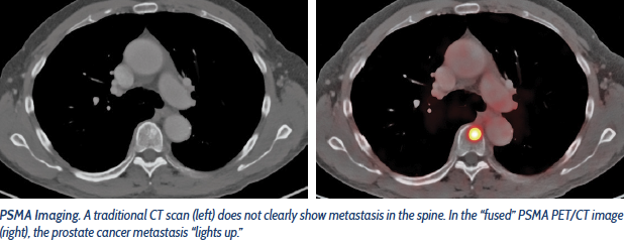PSMA PET Imaging
PSMA PET is a newer, highly sensitive imaging scan that can detect prostate cancer metastases much earlier, when they are much smaller. It is approved for two types of patients: 1) patients with suspected prostate cancer metastasis who are potentially curable by surgery or radiation therapy (for example, patients newly diagnosed with high-risk prostate cancer), and 2) patients who were previously treated for prostate cancer and now have a suspected recurrence, based on elevated PSA levels.
How does it work? PSMA, short for Prostate Specific Membrane Antigen, is a protein found on the surface of prostate cancer cells. The “imaging agent” consists of a chemical that binds to PSMA, honing in on prostate cancer cells wherever they are in the body. Attached to this binding chemical is a radioactive “reporter.” Patients are given a one-time injection of this combination molecule into the bloodstream, “tagging” prostate cancer cells. The patients are then given a scan with an imaging camera that “lights up” areas where the molecule has accumulated—i.e., sites of prostate cancer (see photo).

PSMA PET imaging may help guide your treatment plan. Researchers continue to study how best to use this technology to improve patient outcomes.
Last Reviewed: 12/2023




